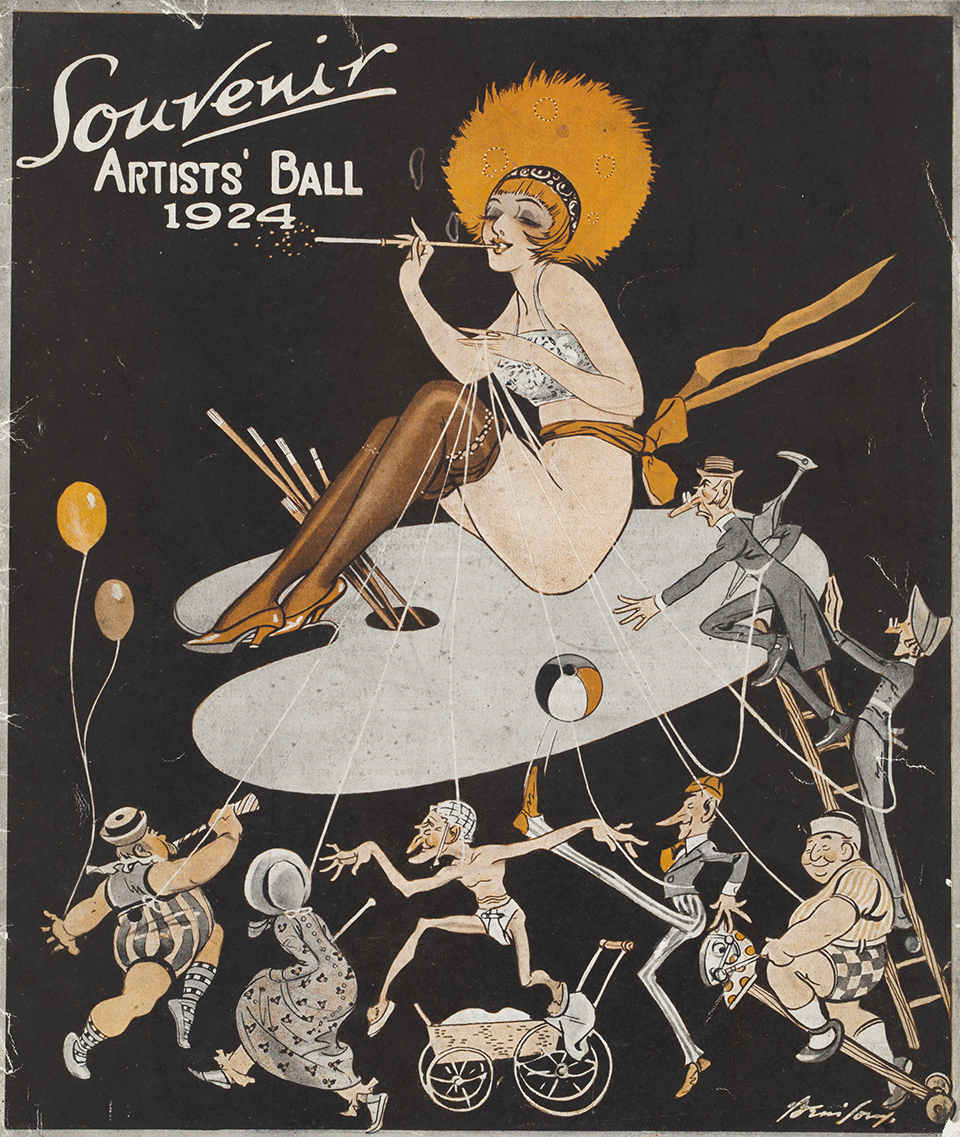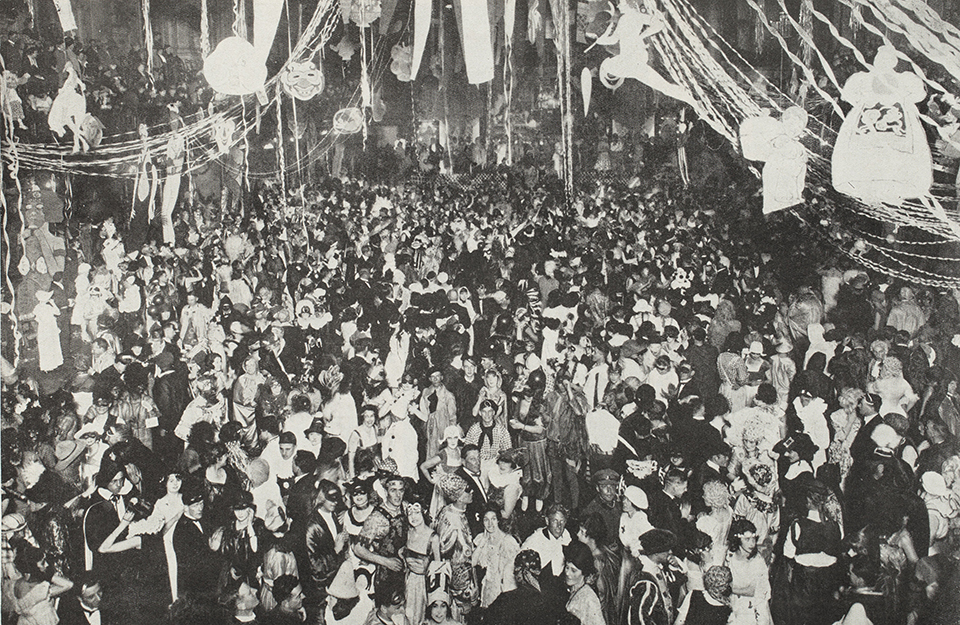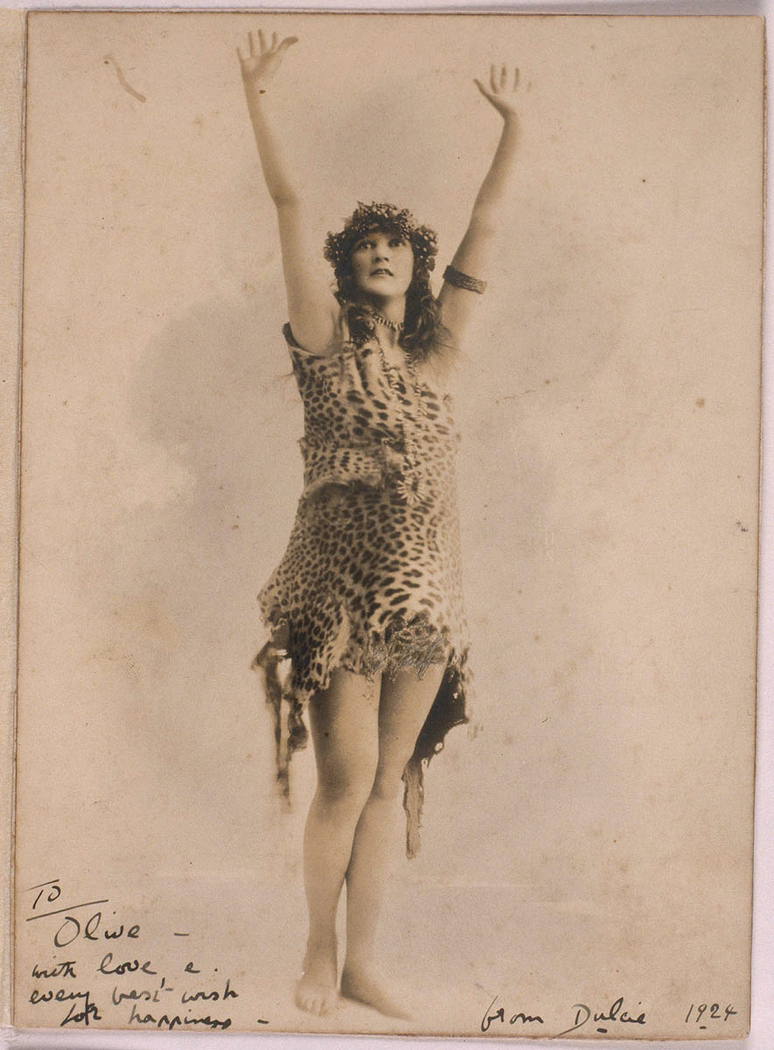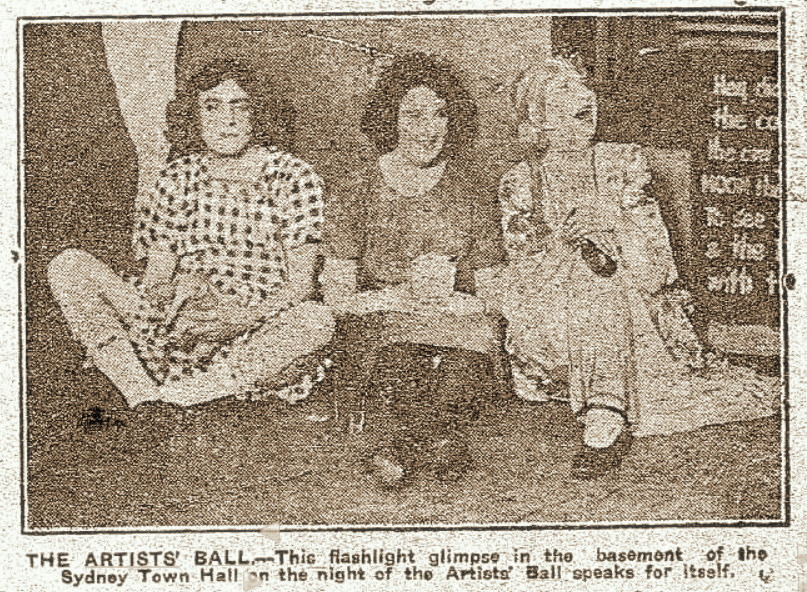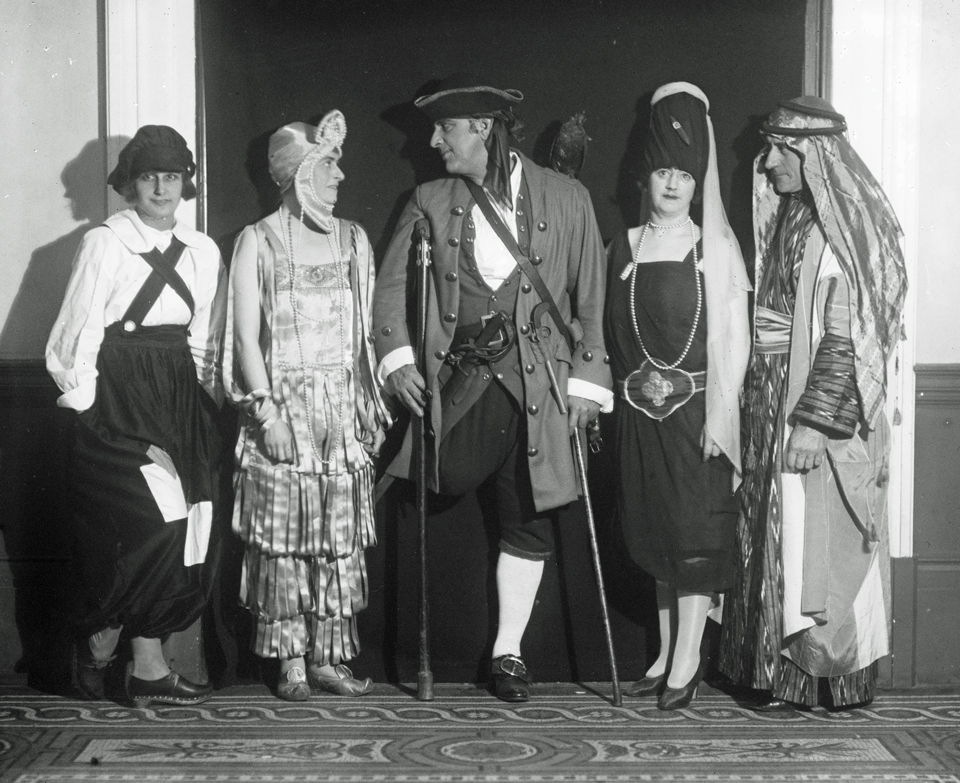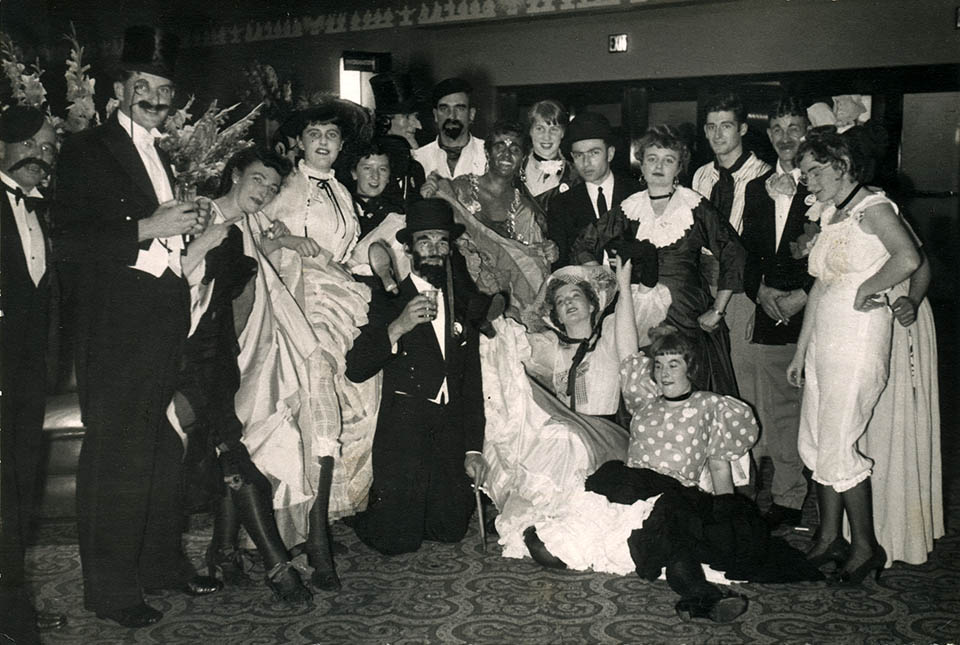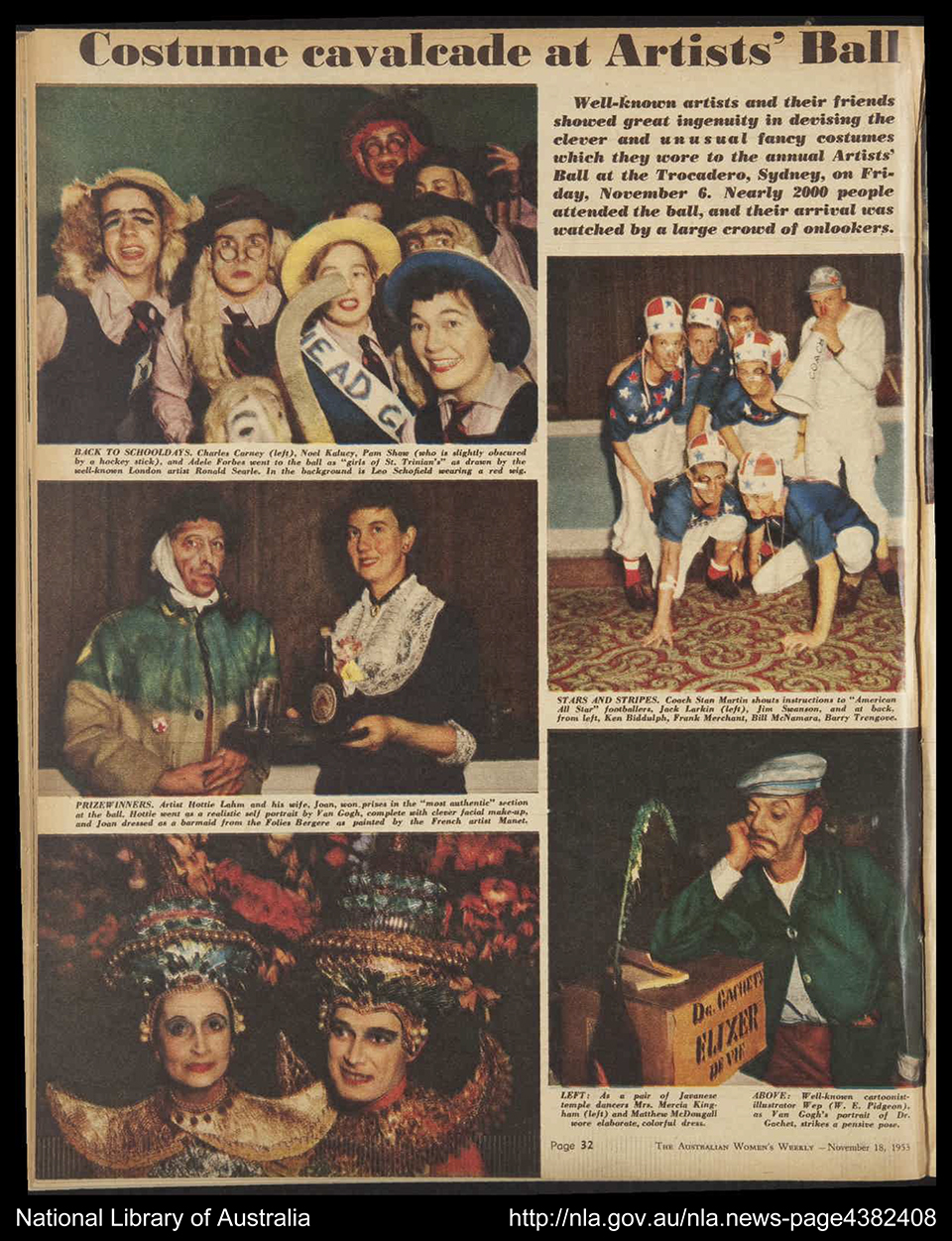The Dictionary of Sydney was archived in 2021.
Scandalous nights - Sydney's artists' balls
Citation
Persistent URL for this entry
To cite this entry in text
To cite this entry in a Wikipedia footnote citation
To cite this entry as a Wikipedia External link
Scandalous nights: Sydney artists' balls
Artists' balls [media]have had a long tradition in Sydney; the first one was held as early as 1881 in the Garden Palace at the Royal Botanic Gardens after the International Exhibition. Up until World War 1, the balls were held annually. Paddington Town Hall was the venue for the balls of 1898 and 1901. Sets and costumes were designed by artists; DH Souter designed a black and white set for the 1898 ball while at the 1901 ball, artists wore costumes lent by JC Williamson with silver hats each representing a tube of colour. Paddington Town Hall was also the site for the Royal Art Society's balls in 1908 and 1909.
[media]In the 1920s, Sydney's artists' balls resumed, taking their cue from their outrageous counterparts held in London, Berlin and Paris. The Parisian artists' balls began in Montmartre in 1892. They were carnival-like celebrations organised by graduates from the Ecole Nationale des Beaux-Arts. Like Sydney's balls, fancy dress was obligatory, with prizes for best dressed and scholarships awarded for needy artists from the profits. Artists Matisse, Vlaminck, Van Dongen, Pascin and the much loved model and muse, Kiki, were regulars at the Paris balls. These soon took on bacchanalian aspects, and were even credited with the invention of the strip-tease, which apparently took place in front of the Moulin Rouge in 1893.
[media]Thousands of party-goers attended Sydney's balls, the majority coming from the Society of Artists, the art department of East Sydney Technical College, the Black and White Artists and students from the University of Sydney. The first ball of the decade, held in the Sydney Town Hall on 21 August 1922, raised around £3,000 for a Red Cross project to establish a pottery workshop for disabled diggers. For this ball, Sydney Town Hall and its basement was transformed into an atmospheric vaudeville-like arena, with enormous grotesque figures and large friezes as decorations. Attendees wore extravagant fancy dress costumes and masks – the masks were removed on the stroke of midnight to reveal artists and models such as George Finey, Rose Lindsay, Theo Cowan, George Lambert and Stan Cross, as well as many of Sydney's social elite.
DH Souter, [media]who supervised the decorations for the 1923 artists' ball, described it as a 'jazz fantasy'. It was at this ball that the famous poet, writer and Queen of Bohemia, Dulcie Deamer, wore her cavewoman outfit. The photograph of Deamer dressed in a wrap-around leopard skin hide complete with a dogtooth necklace has come to symbolize the joi de vivre of the decade, despite Deamer's own protest regarding its relevance.
[media]Perhaps the most notorious of the artists' balls of this decade was held at the Sydney Town Hall in 1924. The ball turned, if not into an orgy, then into a veritable bacchanalia: [1] alcohol flowed freely and spirits were smuggled in in great numbers. Deamer called it the 'Night of the Great Scandal'. The theme of this ball was ‘Back to Childhood’, so George Finey hid a bottle of rum in his nappy, secured with a safety pin, and Jack Lindsay hid whisky flasks in the habit of his friend who had dressed as Friar John. In the basement of the Town Hall the floor was covered in beer. Fights erupted after gatecrashers climbed through the basement windows, and extra police and the fire brigade were eventually called to clear the overcrowded basement which was littered with drunken semi-naked women, broken crockery and high spirited revellers. The Lord Mayor's orderly, Martin Carrick, reported that 'in one place I saw a helpless man and woman vomiting into each other's laps', and in the Ladies Rest Rooms 'men were entering with women and locking themselves in the compartments'. [2]
Such behavior caused outrage with the Sydney authorities intervening. Questions were asked in Parliament, [3] and the newspapers carried detailed reports of the 'licentious goings-on' in the Town Hall. [4] After this debacle, other balls in the 'Golden Decade' were more [media]chaste affairs, held elsewhere, with bans on alcohol and more police on hand. Despite this, Deamer, who attended every artists' ball for thirty years, counted the 1927 ball as her favourite, describing the 'joy-drunk spirit of sheer happiness' enjoyed by those who attended.
[media]During the 1930s and 40s the annual artists balls were held in a variety of venues in Sydney, including the Palais Royal, the David Jones Auditorium, the Trocadero and the Blaxland Galleries. Artists and students attending the balls continued to make the front pages of newspapers. Former National Art School student and teacher Jean Isherwood remembered the headlines in the Sunday Telegraph proclaiming 'Cleopatra in Kitchen Array', when she wore soup strainers for breast plates, key rings for earrings, and a transparent dress to a ball at the Trocadero.
[media]Once again, with the outbreak of war, the balls ceased. In the 1950s and early 1960s, they were held at the Trocadero with themes such as 'Moulin Rouge', 'Witches and Warlocks', Splunge' and 'Arabian Nights'. The balls at 'the Troc' were a magnet for artists and their models and much of Sydney's bohemia, including many cross-dressers. One famous incident involved drag queens arriving in giant removalist vans because their frocks and hairstyles were too large to be transported any other way.
[media]By the early 1960s, most of the annual art balls were transferred to the Paddington Town Hall. The Trocadero management and police were not impressed by the boisterous behaviour of the artists, particularly at the 1961 ball ('Splunge'), when one of the tables caught alight and the fire brigade was called .
Situated close to Sydney's National Art School, the move to the Paddington Town Hall suited the students who were encouraged to design even more lavish sets. NAS club president Bill Huff-Johnston who attended the balls from 1956–1961, recalls one year when the club received an extraordinary account for furniture damage after the ball, with the improbable damage sited as 'teeth marks up chair leg'. Another young student, Barvara Hush, attended the 1962 ball at Paddington, with the theme of 'Dante's Inferno'. She remembers being terrified when the 'Witch of Kings Cross', Rosaleen Norton appeared in the Ladies Room .
Newspaper headlines chronicling the excesses of the balls soon played a part in the banning of the art student balls from Paddington Town Hall as well, and in the 1970s they returned to the Cell Block Theatre at the National Art School. The balls continued in the Cell Block sporadically until 2002, when they once again became an annual event.
References
Margo Beasley, Sydney Town Hall: A Social History, City of Sydney in association with Hale & Iremonger, Sydney, 1998
Jack Lindsay, The Roaring Twenties: Literary Life in Sydney, New South Wales in the Years 1921–26, Bodley Head, London, 1960
Peter Kirkpatrick, The Sea Coast of Bohemia: Literary Life in Sydney's Roaring Twenties, University of Queensland Press, Brisbane, 1992
Dulcie Deamer, The Queen of Bohemia, University of Queensland Press, Brisbane, 1998
Notes
[1] For more details, see Margo Beasley, Sydney Town Hall, A Social History, City of Sydney in association with Hale & Iremonger, Sydney, 1998, pp 54–56
[2] Margo Beasley, Sydney Town Hall, A Social History, City of Sydney in association with Hale & Iremonger, Sydney, 1998, City of Sydney archive record, CRS 34/4138/24
[3] See Legislative Assembly New South Wales, Index to the Votes and Proceedings, NSW Parliament, vol XCVI, 1924, http://www.parliament.nsw.gov.au/hhp/pre1991/votes/indexes/LA%20Votes%20Index%201914-1924.pdf
[4] As examples of the style of coverage, see Evening News, 30 August 1924 and Sunday Times, 1 September 1924


